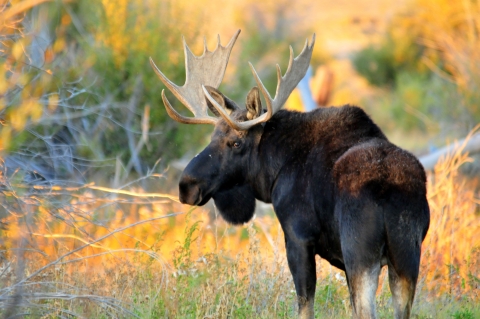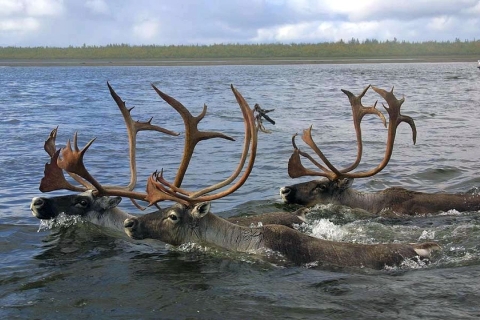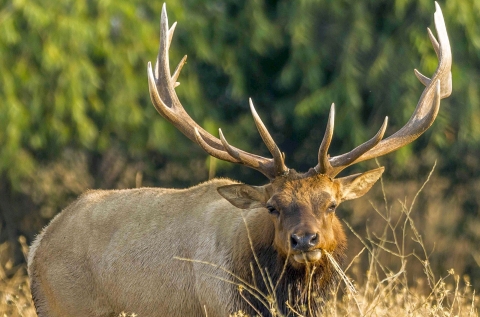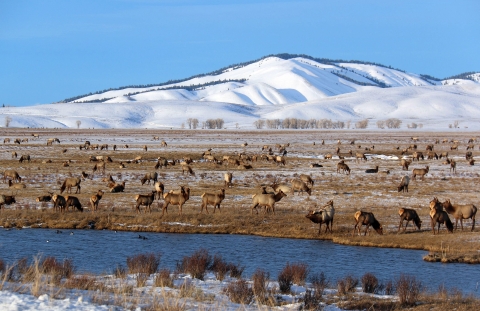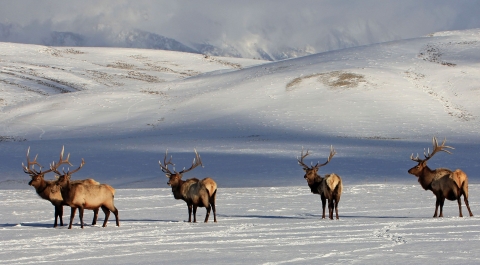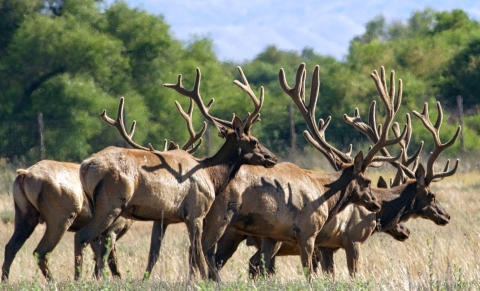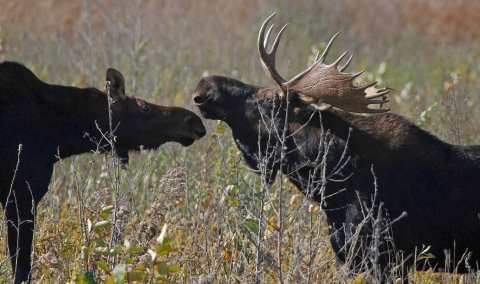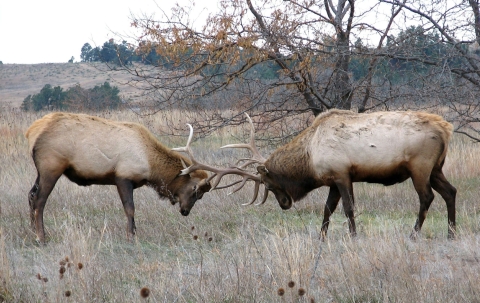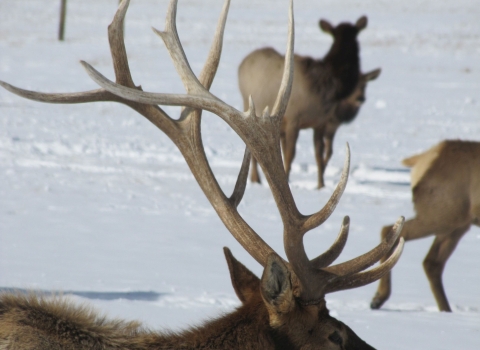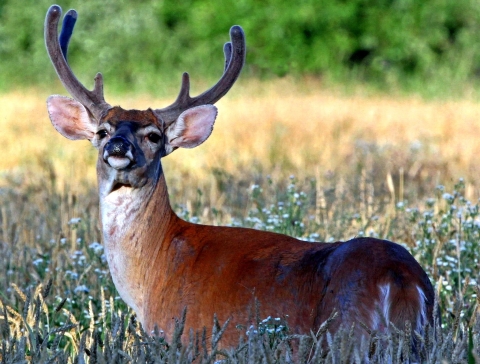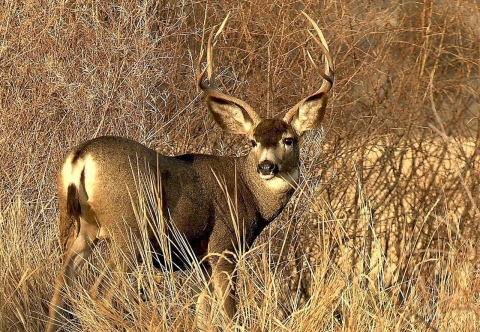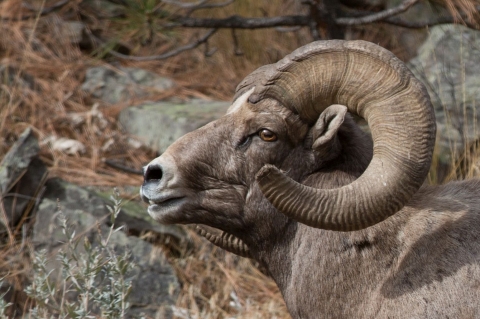Who doesn’t love antlers? National wildlife refuges are home to many thousands of antlered animals from Wyoming to California to Alaska, from Washington state to the Rockies, from the upper Midwest to northern New England.
This story presents a dozen facts about antlers.
Fact 1: Elk, caribou, moose, white-tailed deer and mule deer are among the species native to North America that have antlers. Adult males in all these species have antlers. Most female caribou have antlers, too. Biologically, all of these species belong to the Cervidae family of mammals.
Fact 2:
There are four subspecies of elk in North America: Roosevelt, Rocky Mountain, Tule and Manitoban.
- Roosevelt elk, the largest subspecies, are found in the Northwest, generally west of Interstate 5, including at these refuges: Willapa and Julia Butler Hansen in Washington and Nestucca Bay, William L. Finley and Bandon Marsh in Oregon.
- Rocky Mountain elk inhabit land east of I-5 and into the mountain states.
- Tule elk live in California, including at San Luis and Bitter Creek National Wildlife Refuges.
- Manitoban elk are native to the upper Midwest and Canadian prairie provinces.
Caribou are found at many of Alaska’s 16 national wildlife refuges. Moose are found at refuges in Maine, Minnesota and elsewhere along the nation’s northern tier. White-tailed deer are common nationwide. Mule deer are common in the West.
Fact 3: National Elk Refuge could be considered the antler capital of United States. Some 5,000 to 7,000 Rocky Mountain elk winter annually at the 24,700-acre refuge south of Grand Teton National Park near Jackson, Wyoming. In winter, horse-drawn sleigh rides among the elk are offered at the refuge.
Fact 4: Antlers can grow up to an inch per day, among the fastest-growing animal tissue on the planet. “That growth rate is generally true for elk, and probably true for deer and caribou,” says National Elk Refuge wildlife biologist Eric Cole. “Moose antlers exhibit a palmate growth pattern that does not lend itself to this measurement.”
Fact 5: Antlers are made of bone – “like the parts of any animal skeleton,” Cole says. All antlered animals have a velvet phase when the immature antlers are covered with fine hair. The velvet phase facilitates the growth of the antlers by providing a blood supply to the growing bone. Before breeding season the velvet dries up and the animal rubs the velvet off on vegetation.
Fact 6: Antlers serve various purposes. “Most biologists agree that antlers evolved to facilitate competition among males for females,” says Cole. “Secondary uses include defense against predators and asserting dominance – typically against others of the same species – for food resources.” Antlers also can be used to scrape or rub trees to advertise dominance, knock down fruit and create wallows (dirt or mud depressions in which animals lie or roll to relax, cool down or suppress insects).
Fact 7: During the annual rut (breeding season), males use antlers to display dominance. Females tend to mate with males that have the largest antlers. Sometimes a male will carry vegetation on his antlers. Biologists believe the male is trying to enhance his size. During the rut, bull elk attract breeding harems of five to 30 cows. Bulls bugle – emit loud calls – to attract cows and ward off other bulls. Check out this Tule elk bull bugling at San Luis National Wildlife Refuge (video). For elk, moose and caribou, the rut generally occurs late summer/early fall. For deer, it’s generally November/December.
Fact 8: Size matters. Antler size is an indication of male health because antlers take a considerable amount of resources to produce and carry. Only healthy males can produce the largest antlers. Elk antlers can grow to seven or eight points each, can have a length and spread of four feet and can weigh 20 pounds each.
Fact 9: After the rut – generally in winter or early spring – elk, moose, caribou and deer shed their antlers. Within a given species, animals with the largest sets of antlers typically shed their antlers earliest, Cole says. At the time of shedding, the pedicles – the bony protrusions from which the antlers grow on the animal’s skull – often are injured. Once the pedicles are healed, a week or two after shedding, growth of a new set of antlers typically begins.
Fact 10: “Although a new set of antlers grow each year,” Cole says, “there is a ‘memory’ to antler growth patterns whereby an individual grows antlers of similar conformation each year – similar branching pattern, similar non-typical points, etc.” Injury to the animal, or to the antler itself, in the velvet phase can affect growth patterns.
Fact 11: Policy varies from place to place, but generally it is illegal for the public to remove shed antlers from refuges and parks. However, since 1968, shed antlers have been collected by National Elk Refuge staff members with assistance from the local Jackson District Boy Scouts through a special use permit. Each May, the antlers are sold at a public auction in Jackson, Wyoming, where thousands of pounds of antlers are sold within hours.
Fact 12: Antlers are not horns. Antlers are found in the deer family (Cervidae). Horns are found in the bovine family. Bovines include bison, antelopes, sheep, goats and domestic cattle. Whereas antlers are composed of bone, horns are composed of keratin (same material as hair and fingernails) on the outer portion and live bone on the inner core. Antlers are shed annually; horns grow throughout the life of the animal. Antlers grow from the tip; horns grow from the base. This fun Brain Scoop video explains the difference.


